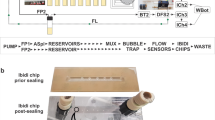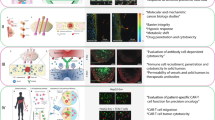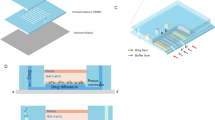Abstract
Using nanoparticles for therapy and imaging holds tremendous promise for the treatment of major diseases such as cancer. However, their translation into the clinic has been slow because it remains difficult to produce nanoparticles that are consistent 'batch-to-batch', and in sufficient quantities for clinical research. Moreover, platforms for rapid screening of nanoparticles are still lacking. Recent microfluidic technologies can tackle some of these issues, and offer a way to accelerate the clinical translation of nanoparticles. In this Progress Article, we highlight the advances in microfluidic systems that can synthesize libraries of nanoparticles in a well-controlled, reproducible and high-throughput manner. We also discuss the use of microfluidics for rapidly evaluating nanoparticles in vitro under microenvironments that mimic the in vivo conditions. Furthermore, we highlight some systems that can manipulate small organisms, which could be used for evaluating the in vivo toxicity of nanoparticles or for drug screening. We conclude with a critical assessment of the near- and long-term impact of microfluidics in the field of nanomedicine.
This is a preview of subscription content, access via your institution
Access options
Subscribe to this journal
Receive 12 print issues and online access
$259.00 per year
only $21.58 per issue
Buy this article
- Purchase on Springer Link
- Instant access to full article PDF
Prices may be subject to local taxes which are calculated during checkout



Similar content being viewed by others
References
Petros, R. A. & DeSimone, J. M. Strategies in the design of nanoparticles for therapeutic applications. Nature Rev. Drug. Discov. 9, 615–627 (2010).
Gregoriadis, G. Drug entrapment in liposomes. FEBS Lett. 36, 292–296 (1973).
Hrkach, J. et al. Preclinical development and clinical translation of a PSMA-targeted docetaxel nanoparticle with a differentiated pharmacological profile. Sci. Transl. Med. 4, 128ra39 (2012). This article describes the translation of the first targeted polymeric nanoparticle for drug delivery from discovery to clinical trials.
Qiao, R., Yang, C. & Gao, M. Superparamagnetic iron oxide nanoparticles: from preparations to in vivo MRI applications. J. Mater. Chem. 19, 6274–6293 (2009).
Haun, J. B. et al. Micro-NMR for rapid molecular analysis of human tumor samples. Sci. Transl. Med. 3, 71ra16 (2011).
Kim, B. Y., Rutka, J. T. & Chan, W. C. Nanomedicine. N. Engl. J. Med. 363, 2434–2443 (2010).
Kamaly, N., Xiao, Z., Valencia, P. M., Radovic-Moreno, A. F. & Farokhzad, O. C. Targeted polymeric therapeutic nanoparticles: design, development and clinical translation. Chem. Soc. Rev. 41, 2971–3010 (2012).
Peer, D. et al. Nanocarriers as an emerging platform for cancer therapy. Nature Nanotech. 2, 751–760 (2007).
Barreto, J. A. et al. Nanomaterials: applications in cancer imaging and therapy. Adv. Mater. 23, H18–H40 (2011).
Shi, J., Xiao, Z., Kamaly, N. & Farokhzad, O. C. Self-assembled targeted nanoparticles: evolution of technologies and bench to bedside translation. Acc. Chem. Res. 44, 1123–1134 (2011).
Murday, J. S., Siegel, R. W., Stein, J. & Wright, J. F. Translational nanomedicine: status assessment and opportunities. Nanomedicine 5, 251–273 (2009).
Chou, L. Y., Ming, K. & Chan, W. C. Strategies for the intracellular delivery of nanoparticles. Chem. Soc. Rev. 40, 233–245 (2011).
Nel, A. E. et al. Understanding biophysicochemical interactions at the nano–bio interface. Nature Mater. 8, 543–557 (2009).
Whitesides, G. M. The origins and the future of microfluidics. Nature 442, 368–373 (2006). An excellent classic review on the present and future of microfluidics by one of the fathers of the field, George Whitesides.
DeMello, A. J. Control and detection of chemical reactions in microfluidic systems. Nature 442, 394–402 (2006).
Johnson, B. K. & Prud'homme, R. K. Mechanism for rapid self-assembly of block copolymer nanoparticles. Phys. Rev. Lett. 91, 118302 (2003). This article describes the mechanism of nanoparticle self-assembly and explains how rapid mixing is key in controlling nanoparticle size.
Chen, T., Hynninen, A. P., Prud'homme, R. K., Kevrekidis, I. G. & Panagiotopoulos, A. Z. Coarse-grained simulations of rapid assembly kinetics for polystyrene-b-poly(ethylene oxide) copolymers in aqueous solutions. J. Phys. Chem. B 112, 16357–16366 (2008).
Karnik, R. et al. Microfluidic platform for controlled synthesis of polymeric nanoparticles. Nano Lett. 8, 2906–2912 (2008).
Capretto, L., Cheng, W., Hill, M. & Zhang, X. Micromixing within microfluidic devices. Top. Curr. Chem. 304, 27–68 (2011).
Rhee, M. et al. Synthesis of size-tunable polymeric nanoparticles enabled by 3D hydrodynamic flow focusing in single-layer microchannels. Adv. Mater. 23, H79–H83 (2011).
Liu, K. et al. A digital microfluidic droplet generator produces self-assembled supramolecular nanoparticles for targeted cell imaging. Nanotechnology 21, 445603 (2010).
Valencia, P. M. et al. Single-step assembly of homogenous lipid-polymeric and lipid-quantum dot nanoparticles enabled by microfluidic rapid mixing. ACS Nano 4, 1671–1679 (2010).
Jahn, A. et al. Preparation of nanoparticles by continuous-flow microfluidics. J. Nanopart. Res. 10, 925–934 (2008).
Besson, C., Finney, E. E. & Finke, R. G. A mechanism for transition-metal nanoparticle self-assembly. J. Am. Chem. Soc. 127, 8179–8184 (2005).
Song, Y., Hormes, J. & Kumar, C. S. Microfluidic synthesis of nanomaterials. Small 4, 698–711 (2008).
Gu, F. X. et al. Targeted nanoparticles for cancer therapy. Nano Today 2, 14–21 (2007).
Shestopalov, I., Tice, J. D. & Ismagilov, R. F. Multi-step synthesis of nanoparticles performed on millisecond time scale in a microfluidic droplet-based system. Lab Chip 4, 316–321 (2004).
Kikkeri, R., Laurino, P., Odedra, A. & Seeberger, P. H. Synthesis of carbohydrate-functionalized quantum dots in microreactors. Angew. Chem. Int. Ed. 49, 2054–2057 (2010).
Marre, S. & Jensen, K. F. Synthesis of micro and nanostructures in microfluidic systems. Chem. Soc. Rev. 39, 1183–1202 (2010).
Zhao, C. X., He, L. Z., Qiao, S. Z. & Middelberg, A. P. J. Nanoparticle synthesis in microreactors. Chem. Eng. Sci. 66, 1463–1479 (2011).
Fraikin, J. L., Teesalu, T., McKenney, C. M., Ruoslahti, E. & Cleland, A. N. A high-throughput label-free nanoparticle analyser. Nature Nanotech. 6, 308–313 (2011).
Birnbaumer, G. et al. Rapid liposome quality assessment using a lab-on-a-chip. Lab Chip 11, 2753–2762 (2011).
Wang, H. et al. A rapid pathway toward a superb gene delivery system: programming structural and functional diversity into a supramolecular nanoparticle library. ACS Nano 4, 6235–6243 (2010). This article is one of the first examples that exploit microfluidic systems for rapid combinatorial synthesis of nanoparticles with a variety of physical and chemical properties.
Chen, D. et al. Rapid discovery of potent siRNA-lipid-nanoparticles enabled by controlled microfluidic formulation. J. Am. Chem. Soc. 134, 6948–6951 (2012).
Kim, Y. et al. Mass production and size control of lipid-polymer hybrid nanoparticles through controlled microvortices. Nano Lett. 12, 3587–3591 (2012).
Dobrovolskaia, M. A., Germolec, D. R. & Weaver, J. L. Evaluation of nanoparticle immunotoxicity. Nature Nanotech. 4, 411–414 (2009).
Cho, E. C., Zhang, Q. & Xia, Y. The effect of sedimentation and diffusion on cellular uptake of gold nanoparticles. Nature Nanotech. 6, 385–391 (2011).
Ziolkowska, K., Kwapiszewski, R. & Brzozka, Z. Microfluidic devices as tools for mimicking the in vivo environment. New J. Chem. 35, 979–990 (2011).
Mahto, S. K., Yoon, T. H. & Rhee, S. W. A new perspective on in vitro assessment method for evaluating quantum dot toxicity by using microfluidics technology. Biomicrofluidics 4, 034111 (2010).
Huh, D., Torisawa, Y. S., Hamilton, G. A., Kim, H. J. & Ingber, D. E. Microengineered physiological biomimicry: organs-on-chips. Lab Chip 12, 2156–2164 (2012).
Huh, D. et al. Reconstituting organ-level lung functions on a chip. Science 328, 1662–1668 (2010). This article describes the design and assembly of a microfluidic system that recreates the alveolar-endothelial interface in lungs.
Kim, H. J., Huh, D., Hamilton, G. & Ingber, D. E. Human gut-on-a-chip inhabited by microbial flora that experiences intestinal peristalsis-like motions and flow. Lab Chip 12, 2165–2174 (2012).
Toh, Y. C. et al. A microfluidic 3D hepatocyte chip for drug toxicity testing. Lab Chip 9, 2026–2035 (2009).
Crane, M. M., Chung, K., Stirman, J. & Lu, H. Microfluidics-enabled phenotyping, imaging, and screening of multicellular organisms. Lab Chip 10, 1509–1517 (2010).
George, S. et al. Use of a high-throughput screening approach coupled with in vivo zebrafish embryo screening to develop hazard ranking for engineered nanomaterials. ACS Nano 5, 1805–1817 (2011).
Shi, W., Wen, H., Lin, B. & Qin, J. Microfluidic platform for the study of Caenorhabditis elegans. Top. Curr. Chem. 304, 323–338 (2011).
Baker, M. Screening: the age of fishes. Nature Meth. 8, 47–51 (2011).
Samara, C. et al. Large-scale in vivo femtosecond laser neurosurgery screen reveals small-molecule enhancer of regeneration. Proc. Natl Acad. Sci. USA 107, 18342–18347 (2010).
Dendukuri, D. & Doyle, P. S. The synthesis and assembly of polymeric microparticles using microfluidics. Adv. Mater. 21, 4071–4086 (2009).
Zhao, J. & Grant, S. F. Advances in whole genome sequencing technology. Curr. Pharm. Biotechnol. 12, 293–305 (2011).
Acknowledgements
This work was supported by the Koch-Prostate Cancer Foundation Award in Nanotherapeutics (R.L. and O.C.F.), the National Cancer Institute Center of Cancer Nanotechnology Excellence at MIT-Harvard (U54-CA151884, R.L. and O.C.F.), and the National Heart, Lung, and Blood Institute Programs of Excellence in Nanotechnology (HHSN268201000045C; R.L. and O.C.F.). P.M.V. is supported by the National Science Foundation graduate research fellowship. We thank B. Timko and F. Karim for assistance in drafting Figs 1 and 2, respectively. We also thank A. Radovic-Moreno, C. Alabi and E. Pridgen for their insightful comments.
Author information
Authors and Affiliations
Corresponding authors
Ethics declarations
Competing interests
The authors declare competing financial interests: O.C.F. and R.L. disclose financial interest in BIND Biosciences and Selecta Biosciences, two biotechnology companies developing nanoparticle technologies for medical applications. BIND and Selecta did not support the aforementioned work, and at present these companies have no rights to any technology or intellectual property developed as part of this work.
Rights and permissions
About this article
Cite this article
Valencia, P., Farokhzad, O., Karnik, R. et al. Microfluidic technologies for accelerating the clinical translation of nanoparticles. Nature Nanotech 7, 623–629 (2012). https://doi.org/10.1038/nnano.2012.168
Received:
Accepted:
Published:
Issue Date:
DOI: https://doi.org/10.1038/nnano.2012.168
This article is cited by
-
Nucleation growth quenching for superior cluster catalysts
Nano Research (2022)
-
High-fidelity transfer of area-selective atomic layer deposition grown HfO2 through DNA origami-assisted nanolithography
Nano Research (2022)
-
Role of drug delivery technologies in the success of COVID-19 vaccines: a perspective
Drug Delivery and Translational Research (2022)
-
A sustainable approach for the synthesis of bismuth molybdate by continuous flow method using custom design reactor and their photocatalytic application for environmental remediation
Applied Nanoscience (2022)
-
Thermally active nanoparticle clusters enslaved by engineered domain wall traps
Nature Communications (2021)



